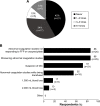Hemostatic assessment, treatment strategies, and hematology consultation in massive postpartum hemorrhage: results of a quantitative survey of obstetrician-gynecologists
- PMID: 26604829
- PMCID: PMC4639551
- DOI: 10.2147/IJWH.S89573
Hemostatic assessment, treatment strategies, and hematology consultation in massive postpartum hemorrhage: results of a quantitative survey of obstetrician-gynecologists
Abstract
Objective: To assess potential diagnostic and practice barriers to successful management of massive postpartum hemorrhage (PPH), emphasizing recognition and management of contributing coagulation disorders.
Study design: A quantitative survey was conducted to assess practice patterns of US obstetrician-gynecologists in managing massive PPH, including assessment of coagulation.
Results: Nearly all (98%) of the 50 obstetrician-gynecologists participating in the survey reported having encountered at least one patient with "massive" PPH in the past 5 years. Approximately half (52%) reported having previously discovered an underlying bleeding disorder in a patient with PPH, with disseminated intravascular coagulation (88%, n=23/26) being identified more often than von Willebrand disease (73%, n=19/26). All reported having used methylergonovine and packed red blood cells in managing massive PPH, while 90% reported performing a hysterectomy. A drop in blood pressure and ongoing visible bleeding were the most commonly accepted indications for rechecking a "stat" complete blood count and coagulation studies, respectively, in patients with PPH; however, 4% of respondents reported that they would not routinely order coagulation studies. Forty-two percent reported having never consulted a hematologist for massive PPH.
Conclusion: The survey findings highlight potential areas for improved practice in managing massive PPH, including earlier and more consistent assessment, monitoring of coagulation studies, and consultation with a hematologist.
Keywords: acquired hemophilia; blood coagulation disorders; disseminated intravascular coagulation; von Willebrand disease.
Figures


Similar articles
-
A global quantitative survey of hemostatic assessment in postpartum hemorrhage and experience with associated bleeding disorders.Int J Womens Health. 2017 Jul 3;9:477-485. doi: 10.2147/IJWH.S132135. eCollection 2017. Int J Womens Health. 2017. PMID: 28740434 Free PMC article.
-
Postpartum hemorrhage: when uterotonics and sutures fail.Am J Hematol. 2012 May;87 Suppl 1:S16-22. doi: 10.1002/ajh.23156. Epub 2012 Mar 19. Am J Hematol. 2012. PMID: 22430921 Review.
-
Prevention and management of postpartum hemorrhage: a comparison of 4 national guidelines.Am J Obstet Gynecol. 2015 Jul;213(1):76.e1-76.e10. doi: 10.1016/j.ajog.2015.02.023. Epub 2015 Feb 28. Am J Obstet Gynecol. 2015. PMID: 25731692
-
Primary postpartum haemorrhage in women with von Willebrand disease or carriership of haemophilia despite specialised care: a retrospective survey.Haemophilia. 2015 Jul;21(4):505-12. doi: 10.1111/hae.12635. Epub 2015 Feb 16. Haemophilia. 2015. PMID: 25688733
-
Unexpected postpartum hemorrhage due to an acquired factor VIII inhibitor.Am J Perinatol. 2014 Sep;31(8):645-54. doi: 10.1055/s-0033-1358768. Epub 2013 Dec 11. Am J Perinatol. 2014. PMID: 24338123 Review.
Cited by
-
The Emergent Pelvic Artery Embolization in the Management of Postpartum Hemorrhage: A Systematic Review and Meta-analysis.Obstet Gynecol Surv. 2021 Apr;76(4):234-244. doi: 10.1097/OGX.0000000000000887. Obstet Gynecol Surv. 2021. PMID: 33908615 Free PMC article.
-
Primary postpartum hemorrhage in women with von Willebrand disease and carriers of hemophilia: a retrospective analysis.Res Pract Thromb Haemost. 2024 Jul 14;8(5):102508. doi: 10.1016/j.rpth.2024.102508. eCollection 2024 Jul. Res Pract Thromb Haemost. 2024. PMID: 39165610 Free PMC article.
-
A global quantitative survey of hemostatic assessment in postpartum hemorrhage and experience with associated bleeding disorders.Int J Womens Health. 2017 Jul 3;9:477-485. doi: 10.2147/IJWH.S132135. eCollection 2017. Int J Womens Health. 2017. PMID: 28740434 Free PMC article.
-
Nonovert disseminated intravascular coagulation (DIC) in pregnancy: a new scoring system for the identification of patients at risk for obstetrical hemorrhage requiring blood product transfusion.J Matern Fetal Neonatal Med. 2022 Jan;35(2):242-257. doi: 10.1080/14767058.2020.1716330. Epub 2020 Feb 3. J Matern Fetal Neonatal Med. 2022. PMID: 31931643 Free PMC article.
References
-
- Khan KS, Wojdyla D, Say L, Gülmezoglu AM, Van Look PF. WHO analysis of causes of maternal death: a systematic review. Lancet. 2006;367(9516):1066–1074. - PubMed
-
- Bonnet MP, Deneux-Tharaux C, Bouvier-Colle MH. Critical care and transfusion management in maternal deaths from postpartum haemorrhage. Eur J Obstet Gynecol Reprod Biol. 2011;158(2):183–188. - PubMed
-
- Borna S, Hantoushzadeh S. Acquired hemophilia as a cause of primary postpartum hemorrhage. Arch Iran Med. 2007;10(1):107–110. - PubMed
-
- Brace V, Kernaghan D, Penney G. Learning from adverse clinical outcomes: major obstetric haemorrhage in Scotland, 2003–2005. BJOG. 2007;114(11):1388–1396. - PubMed
-
- James AH, McLintock C, Lockhart E. Postpartum hemorrhage: when uterotonics and sutures fail. Am J Hematol. 2012;87(Suppl 1):S16–S22. - PubMed
LinkOut - more resources
Full Text Sources
Miscellaneous

